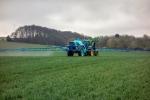H2020 MOSES Project: Crop Water Saving Management with Business Services
- Type Project
- Status Filled
- Execution 2015 -2018
- Assigned Budget 3.768.012,5 €
- Scope Europeo
- Main source of financing Horizon 2020
- Project website Proyecto MOSES
Description
The proposed system focuses on the thematic priorities of the EIP on Water, related to increasing water use efficiency in agriculture, water resource monitoring, and flood and drought risk management; it will comply with INSPIRE. This SME-led project offers irrigated agricultural users an integrated and innovative solution for water management.
Description of activities
The work carried out since the beginning of the project is briefly described below. Requirements definition. Information requirements in all demonstration areas were collected (through questionnaires, email exchanges, web meetings) during project preparation and in the initial stages of the project. Requirements analysis allowed us to identify: - Hierarchical management levels - Water management operations - Information products, their schedule, spatial and temporal resolution. An example for the Moroccan demonstration area is shown in Figure 2. Design. The platform is a set of seven macromodules (satellite data download processors, early crop mapping, unit crop mapping, in-season crop mapping, crop water demand, irrigation forecasting, and seasonal forecasting), integrated into a processing chain (Fig. 3). The design was derived from the requirements, and the modules implement the information products in the blue blocks in Figure 2. Service definition. In the first part of the project, MOSES services were defined based on a requirements analysis. The service definition was then expanded by defining specific KPIs and organizing a campaign to measure them. Lifecycle assessment analysis was then performed. LCA was applied comparatively to a situation with and without MOSES services. The comparison was made by developing specific simulation models to establish and analyze different scenarios. This assessment was based on hypothetical impacts, i.e., what is expected to happen if the WA chooses to advance its strategic decision, following the information provided by the MOSES platform. Communication, dissemination, and impact. These activities were divided into three components: Communication; Market and business analysis; and impact analysis; MOSES exploitation platform. The communication activities began with the design of a logo and templates. Updates on the project and its progress were disseminated through the project website and all social media platforms such as Twitter (https://twitter.com/MOSES_H2020), Instagram (https://www.instagram.com/mosesproject/?hl=it), and LinkedIn (https://www.linkedin.com/groups/8469752). Dissemination events were selected by the management team with all partners. Presentations about the project have been made at events targeting a wide audience as well as at EU events. Communication materials such as brochures and leaflets have been developed to strengthen the MOSES brand. Currently, the platform is available at https://moses.esriitalia.it/portal, and a Web-GIS viewer is available at https://moses.esriitalia.it/portal/home/signin.html?returnUrl=https%3A//moses.esriitalia.it/mosesviewer_rc_en/
Contextual description
The project aimed to provide an integrated and innovative water management solution to individual and collective stakeholders in irrigated agriculture. These priorities are aligned with the objectives of the European Innovation Partnerships (IEP) on Water, one of the five partnerships within the EU2020 Innovation Union. The objective of MOSES was to launch and demonstrate at full-scale implementation an information platform primarily targeting the needs of water procurement and management agencies (e.g., reclamation pools, irrigation districts, etc.) to facilitate irrigation water resource planning, as well as services to farmers to support efforts to reduce water use, monetary and energy costs. The main services supported are: 1. mapping of early-season irrigated crops; 2. seasonal weather forecasting and downscaling; 3. in-season monitoring of crop water requirements and soil water balance; 4. Forecasting of crop and irrigation water demand in the medium and short term. The project is active in four different Demonstration Areas (DAs): in the DA established in Italy, the project was implemented in the first 18 months of activities. The other three DAs were established in Spain, Romania, and Morocco, representing different water procurement and distribution scenarios to obtain a broader definition of the service. The MOSES platform was implemented as planned, and new functionalities were added to respond to specific needs derived from the experience gained with the application in the four DAs. The platform offers multiple and complementary information services through a continuous data flow, with intuitive access and flexible operation. In response to user suggestions, the original design, based on minimum spatial elements, applied to model the soil water balance, defined by cadastral boundaries, was enhanced to model elementary units adaptable to different irrigation management units. This allowed the generation of information that is easily integrated into current irrigation management systems. Upon project completion, it appears feasible to continue MOSES operations by hosting the platform on one of the cloud-based DIAS platforms being developed in response to an initiative from the European Space Agency (ESA).
Objectives
The main objective of MOSES is to implement and demonstrate at full application scale an information platform dedicated to water procurement and management agencies (e.g., reclamation trusts, irrigation districts, etc.) to facilitate irrigation water resource planning, with the goals of: saving water; improving services to farmers; and reducing monetary and energy costs. To achieve these objectives, the MOSES project combines a wide range of data and technological resources into an innovative and integrated platform: EO data, probabilistic seasonal forecasting and numerical weather prediction, crop water requirement and irrigation modeling, and an online GIS decision support system. The spatial scales of services vary from the river basin to the sub-district; users access the system based on their experience and needs. The main components of the system are: 1. Mapping of irrigated crops at the beginning of the season 2. Seasonal weather forecasting and downscaling 3. Seasonal monitoring of evapotranspiration and water availability 4. Seasonal and medium- to short-term irrigation forecasting. Four demonstration areas will be established in Italy, Spain, Romania, and Morocco, in addition to an Indian organization acting as an observer. Different water procurement and distribution scenarios will be considered, collecting data and user needs, interacting with existing local services, and contributing to service definition. Demonstration and training sessions for service operation are planned in the demonstration areas. The proposed system is targeted at the EIP Water "thematic priorities" related to increasing water use efficiency in agriculture, water resource monitoring, and flood and drought risk management; it will be INSPIRE-compliant. This SME-led project offers irrigated agricultural users an integrated and innovative water management solution.
Results
MOSES services represent a major advancement compared to state-of-the-art satellite-based decision support systems for irrigation water management, as such services typically provide near-real-time (NRT) information on crop conditions derived from multispectral imagery data. The MOSES platform provides both monitoring and forecasting at two timescales, i.e., seasonal and daily, to address both the planning and operation of water availability and allocation. Furthermore, MOSES information products are generated at high spatial resolution to support on-farm irrigation management and aggregated into larger spatial units to support water management within complete irrigation schemes. Limited but significant adaptations of the information products have ensured the best possible match with current water management expectations and practices in each DA. The project outcomes are summarized below. MOSES data products meet the demand. There is a general interest in improved management to improve efficiency, although water reserves in reservoirs and canal flows are the main focus. Actual data on available irrigation water volumes are quite heterogeneous, making the evaluation of CWD metrics quite complex. The evaluation of MOSES services was carried out in DA-IT and DA-SP, primarily by comparing CWD metrics with (measured) data on actual irrigation volumes, suggesting moderate but significant room for improvement. (Fig. 4-5) In DA-MO, analyses show the relevance (in principle) of seasonal and information services. In DA-RO, droughts lead to water supply restrictions and yield losses, suggesting high potential for MOSES. There was clear interest in MOSES monitoring of cultivated area, water demand, and phenological status.
Coordinators
- ESRI ITALIA SPA (ESRI-IT)







